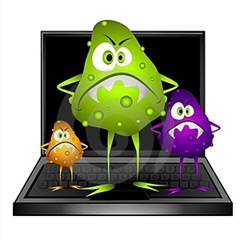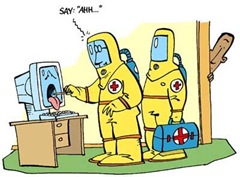Very recently I was trying to help a cousin buy an antivirus which could protect her new laptop from virus attack. At that time I explained to her what was going wrong in her previous PC which we always infected by some virus or the other and what care she had to take in future to prevent frequent virus episodes. At that point she bluntly said that she would not use the pen drive on her laptop any more, since pen drives were the source of all the viruses. I was shocked. I requester her to not to embarrass me in front of anyone with such a foolish statement. Then I went ahead with the explanation of what exactly a computer virus was, and how it spreads in the computer or a network. How much she grasped, I couldn’t gauge by her frequent nods of understanding, but I decided to write something in brief about computer viruses for the benefit of people who belong to my cousin’s category.
To try and mitigate the risks of an infected PC, we need to answer this three questions:
What is a Computer Virus?
What are the Symptoms?
How does it Spread?
How to prevent the spread?
About Computer Virus
- So what is a computer virus? In short, the computer virus is a program, a program written by a human being. The intention behind this program to change the behaviour of the computer to create any kind of disruption and loss to others. A computer virus is not a biological living creature, hence it cannot be thought of as a medical viruses. A computer virus is not something, like fungus, which infects a pen drive or a hard drive automatically.
- A virus in a computer is a file which tries to delete data, multiply itself, transmit security information or do many such things without the knowledge of the computer user. A very simple form of a virus can be the autorun files which are present in the compact disks. A normal autorun file will try to run the contents of the CD when it is inserted in to the CD drive. This was designed for the ease of the use, but later on became an easy target for virus writers to run a malicious code and propagate it on any computer which gives access to this sort of file. Using specific programming techniques, the programmers have managed to delete precious data using the autorun files created by them.
- These kind of viruses may be visible as a file, or may be embedded/masked in any common file type like a shortcut, or a document file, a media file etc. The user, unknowing to the fact that it is a virus, runs the file and the virus program embedded in this file does the rest.
Symptoms
- The viruses try to delete some data, corrupt other files, transmit user information to its programmer, multiply itself on the network and slows down the system. Usable functionality of the operation system is reduced drastically. The computer slows down. Hard disk, CPU and RAM usage might significantly
 increase. Some viruses are even capable or creating havoc in the hardware(RAM) and cause a system crash more frequently. In many cases, the entire computer with its operating system files get corrupted before the user even knows that the computer is infected. A very easy way to know that the computer is infected is when it slows down even though you have not installed any big application, or it starts crashing frequently.
increase. Some viruses are even capable or creating havoc in the hardware(RAM) and cause a system crash more frequently. In many cases, the entire computer with its operating system files get corrupted before the user even knows that the computer is infected. A very easy way to know that the computer is infected is when it slows down even though you have not installed any big application, or it starts crashing frequently. - Have you ever come across a .exe file with the same name as the folder in which it is places? Do you ever remember putting that file in their? Most probably not, since it is a virus. Double clicking(or running) the file will help propagate this virus to your entire computer.
- I once had an incident some years back when all the .exe files on my computer were infected and I had to delete all of them, and in the end, had to format my entire PC, since they kept on infecting the .exe file of my antivirus program.
Spread
- This is where the pen drive factor comes in. I use the word factor because pen drive is just one small factor. The biggest contributor to the spread of the viruses is the internet.
- Most of the viruses are designed to multiply by some means or the other. Let’s say you are browsing an unverified site, as it promises good shopping deals. At one point it asks you to click on a link to download a coupon information. It might be actually a virus program masked as a document file. Once you download and run it, it will run as a normal document file, or might show you that it is a corrupt file. But in the background, the virus code embedded in to it has already started its work of spreading the virus code to other files on the hard drive. Thus even before you know it, your files on the hard drive are infected. If you do not have proper scanning and cleaning tools, you are sure to pass on this file, or any other file on the computer to your friends on a pen drive, hard drive, CD or via email in its infected state.
- Downloading unverified contents from unknown sites is one of the source of this viruses. But once downloaded, you never know how the virus has behaved and altered your computer. If the computer is on a local network, it is probable that the entire network will get infected.
Prevention
- Using an antivirus is the best way to prevent these virus attacks. Previously I was in the habit of using free antivirus programs, but the result was that my computer had to be formatted every 3-5 months. Now I have started using paid antivirus programs and I have not formatted my PC since 2 years.
- If you have a license copy of windows, Microsoft essentials is the free security program which will give good results. I personally use Kaspersky, but MacAfee and Norton programs are also good.
- Always use license copy of operating system and antivirus since they get security updates from the manufacturers from time to time. This updates plug in the loopholes which can be utilized by virus creators to attack your system.
- Always update your antivirus to latest virus database. This helps the program in recognizing the viruses better. Better still, keep the auto update option on, if you have a 24 hours running internet.
- Scan your PC/Laptop at least once a week to find out if any file is infected. Never open a file from the pen drive without scanning the entire drive first. Disable autorun, or at least configure it in such a way that it asks you what to do, when an external media is attached.
- In place of antivirus, try to buy a internet security program. This program helps in identifying malicious sites and warn you beforehand. Antivirus features come preinstalled.
- An antivirus program with proactive defense mechanism is much better then that with a reactive defense and cleanup mechanism.
Following all this steps should help you keep your system virus free and your data safe and secure.
Some light on the types of viruses here.
